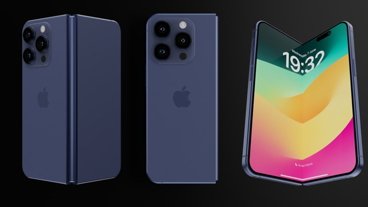A paper published in the current issue of Science and covered by the United Kingdom's Times Online describes the technology along the lines of NAND flash memory, only faster and with considerably longer expected lifespan.
Dubbed 'racetrack' memory, it's said to store information inside the walls that exist between magnetic domains, such as those arranged on the surface of a silicon wafer. Thus, information moves around the columns at extremely high speeds compared to traditional storage mediums — hence the racetrack name.
Scientists at IBM say the technology could pave the way for devices such as digital media players that can hold about a half million songs, cost far less to produce than today's models, and run on a single battery charge for weeks at a time.
"The promise of racetrack memory - for example, the ability to carry massive amounts of information in your pocket - could unleash creativity leading to devices and applications that nobody has imagined yet," said Stuart Parkin, who leads the team of research for IBM out at the company's research centre in San Jose, Calif.
He added that racetrack memory could lead to the development of "'three-dimensional micro-electronics', breaking with the tradition of scientists trying to fit an ever greater number on transistors on an ultra-thin piece of silicon shaped like a wafer."
Although still exploratory in its current form, IBM expects racetrack memory to begin cropping up in electronic devices within the next ten years.
 Katie Marsal
Katie Marsal







 Bon Adamson
Bon Adamson
 Marko Zivkovic
Marko Zivkovic
 Amber Neely
Amber Neely
 Malcolm Owen
Malcolm Owen


 Christine McKee
Christine McKee


-m.jpg)






46 Comments
This is cool news, I guess well have wikipesia in our pocket soon! (as if we don't already!)
A new form of digital storage technology under development at IBM could deliver more than tenfold increases in both the storage capacity and battery life of handheld gadgets like Apple's iPod and iPhone, according to the company's claims.
A paper published in the current issue of Science and covered by the United Kingdom's Times Online describes the technology along the lines of NAND flash memory, only faster and with considerably longer expected lifespan.
Dubbed 'racetrack' memory, it's said to store information inside the walls that exist between magnetic domains, such as those arranged on the surface of a silicon wafer. Thus, information moves around the columns at extremely high speeds compared to traditional storage mediums -- hence the racetrack name.
Scientists at IBM say the technology could pave the way for devices such as digital media players that can hold about a half million songs, cost far less to produce than today's models, and run on a single battery charge for weeks at a time.
"The promise of racetrack memory - for example, the ability to carry massive amounts of information in your pocket - could unleash creativity leading to devices and applications that nobody has imagined yet," said Stuart Parkin, who leads the team of research for IBM out at the company's research centre in San Jose, Calif.
He added that racetrack memory could lead to the development of "'three-dimensional micro-electronics', breaking with the tradition of scientists trying to fit an ever greater number on transistors on an ultra-thin piece of silicon shaped like a wafer."
Although still exploratory in its current form, IBM expects racetrack memory to begin cropping up in electronic devices within the next ten years.
[ View this article at AppleInsider.com ]
Excellent!
Although still exploratory in its current form, IBM expects racetrack memory to begin cropping up in electronic devices within the next ten years.
[ View this article at AppleInsider.com ]
I was on the edge of my seat until I read the last bit.
OR, Apple could dump a ton of it's cash reserves to speed up the development of this technology claiming exclusive, somewhat exclusive or non exclusive... rights from IBM to it's use.
Put the new drives in the 3rd gen iPhone (post 3G) , release it in June 2009 , effectively and severely crippling, and practically wiping every cell manufacture from existence in a single year..........all but Nokia because there will always be a market for junk